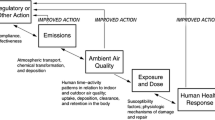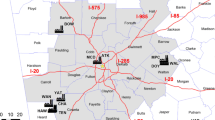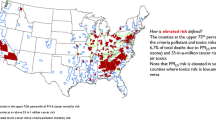Abstract
Monitoring and enforcement are an important part of any regulatory regime, and the costs of such regulatory actions should be justified by improvements in environmental performance. Among air pollutants, particulate matter has the greatest health impacts: the EPA estimates that reductions in ambient particulate matter will have prevented 195,500 cases of premature mortality by 2020. This article is the first to study the impact of monitoring and enforcement actions on emissions of criteria pollutants, which are commonly found air pollutants such as ozone and particulate matter. Previous research on criteria pollutants has been limited as data are not easily available. This article studies both specific and general deterrence. It shows that penalties produce a small but statistically significant specific deterrence impact and inspections produce a general deterrence impact: increasing the average number of inspections at other facilities in the same county by one decreases emissions by 2.7 %.




Similar content being viewed by others
Notes
Local air districts are responsible for almost 99 % of the regulatory actions in my data, so my discussion focuses on air district policy and practice, not EPA policy and practice. I base this description of air district policy on discussions with staff at the four largest air districts, which constitute 80 % of my sample.
Administrative orders may include other requirements. For instance, an administrative order could include a shutdown order, which requires the facility to stop operating the particular piece of equipment, or it could include a variance, which relaxes the facility’s permit restrictions. Obviously, the shutdown order is far more costly than the variance, and this aspect of the enforcement process is important. However, I do not have any of these details about the administrative orders.
High-priority violations are violations that the EPA believes should receive the “highest scrutiny and oversight” (EPA 1998, p. 3). These include more serious permit, emissions, and testing violations, and chronic violations. All districts report high-priority violations; the San Joaquin Valley Air Pollution Control District reports some of its violations that are not considered high-priority violations, and the South Coast Air Quality Management District reports all of its violations regardless of whether they are considered high-priority violations.
Regulatory authorities also have other types of enforcement actions at their disposal, such as notices to comply. However, as these are not reported to the EPA database, I do not discuss them.
The EPA adopted a new Compliance Monitoring Strategy in October of 2001 (EPA 2001). This introduced new types of regulatory actions and changed the recommended inspection frequency.
I determine the facility’s start date using the earliest entry of compliance data or any regulatory action at the facility.
Note that the data only show whether the facility received an enforcement action; they do not specify which pollutant the enforcement action concerns. Thus, I cannot tell if the facility violated a \(\hbox {NO}_{\mathrm{x}}\) emissions limit or some other permit condition. Additionally, while some of the water pollution literature used information on individual effluent pipes within the facility, my data treat the facility as the unit of observation, and I do not have information on individual smokestacks within a facility. Lastly, while one firm may own many facilities, the data are at the facility level, so I study the facility as the unit of observation, not the firm.
A Hausman test rejects the random effects model in favor of the fixed effects model \((p < 0.01)\).
References
Bureau of Economic Analysis (1969–2012). Regional economic accounts. U.S. Department of Commerce. http://www.bea.gov/regional/downloadzip.cfm. Accessed 11 January 2015.
Bureau of Labor Statistics (1999–2012). Labor force data by county, annual averages. U.S. Department of Labor. http://www.bls.gov/lau/#tables. Accessed 11 January 2015.
California Air Resources Board (1995–2012). Emissions inventory data. http://www.arb.ca.gov/app/emsinv/facinfo/facinfo.php. Accessed 1 November 2014.
Clean Air Act (2012). 42 U.S.C. §§7401–7671q.
Cohen, M. A. (1999). Monitoring and enforcement of environmental policy. In T. Tietenberg & H. Folmer (Eds.), International yearbook of environmental and resource economics 1999/2000 (pp. 44–106). Northampton, MA: Edward Elgar.
Deily, M. E., & Gray, W. B. (2007). Agency structure and firm culture: OSHA, EPA, and the steel industry. Journal of Law, Economics, and Organization, 23(3), 685–709.
Earnhart, D. (2004a). Panel data analysis of regulatory factors shaping environmental performance. Review of Economics and Statistics, 86(1), 391–401.
Earnhart, D. (2004b). Regulatory factors shaping environmental performance at publicly-owned treatment plants. Journal of Environmental Economics and Management, 48, 655–681.
Gray, W. B., & Deily, M. E. (1996). Compliance and enforcement: Air pollution regulation in the U.S. steel industry. Journal of Environmental Economics and Management, 31(1), 96–111.
Gray, W. B., & Shadbegian, R. J. (2005). When and why do plants comply? Paper mills in the 1980s. Law and Policy, 27(2), 238–261.
Gray, W. B., & Shimshack, J. P. (2011). The effectiveness of environmental monitoring and enforcement: A review of the empirical evidence. Review of Environmental Economics and Policy, 5(1), 3–24.
Hanna, R. N., & Oliva, P. (2010). The impact of inspections on plant-level air emissions. B.E. Journal of Economic Analysis and Policy, 10(1), Art. 19. http://www.bepress.com/bejeap/vol10/iss1/art19.
Keohane, N. O., Mansur, E. T., & Voynov, A. (2009). Averting regulatory enforcement: Evidence from new source review. Journal of Economics and Management Strategy, 19(1), 75–104.
Kleit, A. N., Pierce, M. A., & Hill, R. C. (1998). Environmental protection, agency motivations, and rent extraction: The regulation of water pollution in Louisiana. Journal of Regulatory Economics, 13(2), 121–137.
Laplante, B., & Rilstone, P. (1996). Environmental inspections and emissions of the pulp and paper industry in Quebec. Journal of Environmental Economics and Management, 31(1), 19–36.
Magat, W. A., & Viscusi, W. K. (1990). Effectiveness of the EPA’s regulatory enforcement: The case of industrial effluent standards. Journal of Law and Economics, 33(2), 331–360.
Nadeau, L. W. (1997). EPA effectiveness at reducing the duration of plant-level noncompliance. Journal of Environmental Economics and Management, 34(1), 54–78.
Shimshack, J. P. (2014). The economics of environmental monitoring and enforcement. Annual Review of Resource Economics, 6, 339–360.
Shimshack, J. P., & Ward, M. B. (2005). Regulator reputation, enforcement, and environmental compliance. Journal of Environmental Economics and Management, 50(3), 519–540.
Shimshack, J. P., & Ward, M. B. (2008). Enforcement and over-compliance. Journal of Environmental Economics and Management, 55(1), 90–105.
Stafford, S. L. (2002). The effect of punishment on firm compliance with hazardous waste regulations. Journal of Environmental Economics and Management, 44(2), 290–308.
Stafford, S. L. (2003). Assessing the effectiveness of state regulation and enforcement of hazardous waste. Journal of Regulatory Economics, 23(1), 27–41.
U.S. Census Bureau (2000–2012). Population estimates: Sex, race, and hispanic origin. U.S. Department of Commerce. http://www.census.gov/popest/data/counties/asrh/2009/CC-EST2009-RACE6.html. Accessed 11 January 2015.
U.S. Environmental Protection Agency (1998). The timely and appropriate enforcement response to high priority violations. http://www.epa.gov/enforcement/air/documents/policies/stationary/issue-ta-rpt.pdf.
U.S. Environmental Protection Agency (2001). Clean air act stationary source compliance monitoring strategy. http://www.epa.gov/compliance/resources/policies/monitoring/cmspolicy.pdf.
U.S. Environmental Protection Agency (2011a). The benefits and costs of the clean air act, 1990 to 2020. http://www.epa.gov/oar/sect812/prospective2.html.
U.S. Environmental Protection Agency (2011b). AFS data elements included in the ECHO data download. http://www.epa-echo.gov/ideadownloads/2011/AFS_summary.pdf.
U.S. Environmental Protection Agency (2012). Enforcement and compliance history online, detailed facility report: Data dictionary. http://www.epa-echo.gov/echo/dfr_data_dictionary.html.
U.S. Environmental Protection Agency (1979–2012). Green book. http://www.epa.gov/airquality/greenbook/data_download.html. Accessed 20 January 2015.
U.S. Environmental Protection Agency (1990–2012). Air facility system data set. http://www.epa-echo.gov/echo/idea_download.html#downloads. Accessed 19 October 2014.
Acknowledgments
I am grateful to Christian Anderson, Mohan Balagopalan, John Borton, Nancy Feldman, Tony Gambardella, Magen Holloway, Morgan Lambert, Betty Laudig, Ken Mangelsdorf, Ed Pupka, and Craig Strommen for helping me understand regulatory policy. I also thank Mark A. Cohen, Paige M. Skiba, Michael P. Vandenbergh, and W. Kip Viscusi, as well as two anonymous referees for helpful comments.
Author information
Authors and Affiliations
Corresponding author
Rights and permissions
About this article
Cite this article
Lim, J. The impact of monitoring and enforcement on air pollutant emissions. J Regul Econ 49, 203–222 (2016). https://doi.org/10.1007/s11149-016-9293-7
Published:
Issue Date:
DOI: https://doi.org/10.1007/s11149-016-9293-7




